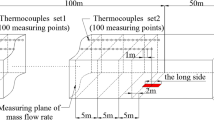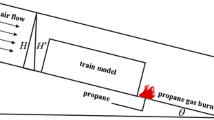Abstract
Model-scale experimental tests and numerical simulations were conducted to investigate the characteristics of the smoke overflow at the lateral carriage doors and the smoke temperature below the tunnel ceiling of a carriage fire in a longitudinally ventilated tunnel. Results indicates that the smoke overflows from the carriage into the tunnel through the lateral doors downstream of the fire source under the impact of longitudinal ventilation. Depending on the fire location, the amount of the overflow smoke exhibited either an inverted V-shaped variation or a monotonical increase with the door position. Multiple peaks in the smoke temperature below the tunnel ceiling is attributed to the uneven distribution of the overflow smoke. A dimensional analysis revealed a quantifiable relationship between the heat flow of the overflow smoke and the peak temperatures below the tunnel ceiling. Consequently, an empirical model was developed to predict the maximum smoke temperature below the tunnel ceiling under different heat release rates and longitudinal ventilation velocities. These findings are excepted to enhance the understanding of carriage fires and provide a theoretical guidance for future ventilation and safety designs in subway systems.













Similar content being viewed by others
References
Ji J, Tan T, Gao Z, Wan H, Zhu J, Ding L (2019) Numerical investigation on the influence of length–width ratio of fire source on the smoke movement and temperature distribution in tunnel fires. Fire Technol 55:963–979. https://doi.org/10.1007/s10694-018-00814-4
Weng M, Lu X, Liu F, Du C (2016) Study on the critical velocity in a sloping tunnel fire under longitudinal ventilation. Appl Therm Eng 94:422–434. https://doi.org/10.1016/j.applthermaleng.2015.10.059
Tang F, He Q, Mei F, Wang Q, Zhang H (2018) Effect of ceiling centralized mechanical smoke exhaust on the critical velocity that inhibits the reverse flow of thermal plume in a longitudinal ventilated tunnel. Tunn Undergr Space Technol 82:191–198. https://doi.org/10.1016/j.tust.2018.08.039
Ji J, Wang Z, Ding L, Yu L, Gao Z, Wan H (2019) Effects of ambient pressure on smoke movement and temperature distribution in inclined tunnel fires. Int J Therm Sci 145:106006. https://doi.org/10.1016/j.ijthermalsci.2019.106006
Huang Y, Li Y, Li J, Dong B, Bi Q, Li Y, Li J (2019) Experimental investigation on temperature profile with downstream vehicle in a longitudinally ventilated tunnel. Exp Therm Fluid Sci 103:149–156. https://doi.org/10.1016/j.expthermflusci.2019.01.006
Chen C, Zhang Y, Lei P, Jiao W (2020) A study for predicting the maximum gas temperature beneath ceiling in sealing tactics against tunnel fire. Tunn Undergr Space Technol 98:103275. https://doi.org/10.1016/j.tust.2019.103275
Guo Q, Zhu H, Zhang Y, Yan Z (2020) Theoretical and experimental studies on the fire-induced smoke flow in naturally ventilated tunnels with large cross-sectional vertical shafts. Tunn Undergr Space Technol 99:103359. https://doi.org/10.1016/j.tust.2020.103359
He K, Shi L, Zhang S, Cong W, Yang H, Cheng X (2023) Experimental study on temperature attenuation of smoke flow driven by dual fire sources in a tunnel. Tunn Undergr Space Technol 134:105004. https://doi.org/10.1016/j.tust.2023.105004
Li Q, Kang J, Wu Y, Luo J (2022) Theoretical and numerical study of smoke back-layering length for an inclined tunnel under longitudinal ventilation. Fire Technol 58:2143–2166. https://doi.org/10.1007/s10694-022-01250-1
Li Z, Zhang Y, Jiang H, Tang C, Luo D, Chen L, Lin Y, Li T (2022) Effect of fire source elevation on the smoke spreading characteristics in an extra-long tunnel. Fire Technol. https://doi.org/10.1007/s10694-022-01299-y
Lönnermark A, Ingason H, Li YZ, Kumm M (2017) Fire development in a 1/3 train carriage mock-up. Fire Saf J 91:432–440. https://doi.org/10.1016/j.firesaf.2017.03.016
Shi C, Zhong M, Chen C, Jiao W, Li J, Zhang Y, Zhang L, Li Y, He L (2020) Metro train carriage combustion behaviors – Full-scale experiment study. Tunn Undergr Space Technol 104:103544. https://doi.org/10.1016/j.tust.2020.103544
Ng YW, Chow WK, Cheng CH, Chow CL (2019) Scale modeling study on flame colour in a ventilation-limited train car pool fire. Tunn Undergr Space Technol 85:375–391. https://doi.org/10.1016/j.tust.2018.12.026
Peng M, Cheng X, Cong W, Yang H, Shahid MU, Yuen R, Zhang H (2021) Experimental study on temperature profile in long-narrow compartment fire with multiple lateral openings. Tunn Undergr Space Technol 117:104018. https://doi.org/10.1016/j.tust.2021.104018
Peng M, Cheng X, Cong W, Yuen R (2020) Experimental investigation on temperature profiles at ceiling and door of subway carriage fire. Fire Technol 57:439–459. https://doi.org/10.1007/s10694-020-01010-z
Peng M, Shi L, He K, Yang H, Cong W, Cheng X, Richard Y (2020) Experimental study on fire plume characteristics in a subway carriage with doors. Fire Technol 56:401–423. https://doi.org/10.1007/s10694-019-00882-0
Meng N, Wang Q, Liu Z, Li X, Yang H (2017) Smoke flow temperature beneath tunnel ceiling for train fire at subway station: Reduced-scale experiments and correlations. Appl Therm Eng 115:995–1003. https://doi.org/10.1016/j.applthermaleng.2017.01.027
Ren F, Shi C, Li J, Che H, Xu X (2021) Numerical study on the flow characteristics and smoke temperature evolution under double fires condition with a metro train in tunnel. Tunn Undergr Space Technol 114:103943. https://doi.org/10.1016/j.tust.2021.103943
Tang F, He Q, Chen L, Li P (2019) Experimental study on maximum smoke temperature beneath the ceiling induced by carriage fire in a tunnel with ceiling smoke extraction. Sustain Cities Soc 44:40–45. https://doi.org/10.1016/j.scs.2018.09.026
Zhang H, Sun J, Zhang G, Zhou X, Pan Y (2021) Experimental study on the tunnel temperature distribution under the coupling effect of train blocking and fire inside the carriage. Tunn Undergr Space Technol 112:103915. https://doi.org/10.1016/j.tust.2021.103915
Shi C, Li J, Xu X (2021) Full-scale tests on smoke temperature distribution in long-large subway tunnels with longitudinal mechanical ventilation. Tunn Undergr Space Technol. https://doi.org/10.1016/j.tust.2020.103784
Cong W, Shi L, Shi Z, Peng M, Yang H, Zhang S, Cheng X (2020) Effect of train fire location on maximum smoke temperature beneath the subway tunnel ceiling. Tunn Undergr Space Technol 97:103282. https://doi.org/10.1016/j.tust.2020.103282
Fan C, Ji J, Li Y, Ingason H, Sun J (2017) Experimental study of sidewall effect on flame characteristics of heptane pool fires with different aspect ratios and orientations in a channel. Proc Combust Inst 36:3121–3129. https://doi.org/10.1016/j.proci.2016.06.196
Guo F, Ding L, Gao Z, Yu L, Ji J (2020) Effects of wind flow and sidewall restriction on the geometric characteristics of propane diffusion flames in tunnels. Energy 198:117332. https://doi.org/10.1016/j.energy.2020.117332
Yao Y, He K, Peng M, Shi L, Cheng X (2021) The maximum gas temperature rises beneath the ceiling in a longitudinal ventilated tunnel fire. Tunn Undergr Space Technol 108:103672. https://doi.org/10.1016/j.tust.2020.103672
McGrattan K, Hostikka S, Floyd J, Vanella M, Craig W, Overholt K (2017) Fire dynamics simulator user’s guide sixth edition. NIST special publication 1019:1–339. https://doi.org/10.6028/NIST.SP.1019
Wang F, Liu F, Obadi I, Weng M (2021) Study on the smoke propagation characteristics of metro tunnel fire under the effects of piston wind. Indoor Built Environ 32:149–169. https://doi.org/10.1177/1420326X21998420
Huang Y, Li Y, Dong B, Li J, Liang Q (2018) Numerical investigation on the maximum ceiling temperature and longitudinal decay in a sealing tunnel fire. Tunn Undergr Space Technol 72:120–130. https://doi.org/10.1016/j.tust.2017.11.021
Delichatsios MA, Lee Y-P, Tofilo P (2009) A new correlation for gas temperature inside a burning enclosure. Fire Saf J 44:1003–1009. https://doi.org/10.1016/j.firesaf.2009.06.009
Li M, Gao Z, Ji J, Li K, Sun J (2017) Wind effects on flame projection probability from a compartment with opposing openings. Fire Saf J 91:414–421. https://doi.org/10.1016/j.firesaf.2017.04.037
Kurioka H, Oka Y, Satoh H, Sugawa O (2003) Fire properties in near field of square fire source with longitudinal ventilation in tunnels. Fire Saf J 38:319–340. https://doi.org/10.1016/s0379-7112(02)00089-9
Lee YP, Delichatsios MA, Silcock GWH (2007) Heat fluxes and flame heights in façades from fires in enclosures of varying geometry. Proc Combust Inst 31:2521–2528. https://doi.org/10.1016/j.proci.2006.08.033
Acknowledgements
This work was funded by Natural Science Research Project of Anhui Educational Committee (2022AH050823), Scientific Research Foundation for High-level Talents of Anhui University of Science and Technology (2022yjrc110), and National Key R&D Program of China under Grant (No. 2022YFC3005201). We sincerely appreciate these supports.
Author information
Authors and Affiliations
Contributions
WC: Conceptualization. Writing—Original Draft, Funding Acquisition. XC: Investigation. LS: Writing—Review & Editing. KH: Supervision, Funding Acquisition.
Corresponding author
Additional information
Publisher's Note
Springer Nature remains neutral with regard to jurisdictional claims in published maps and institutional affiliations.
Rights and permissions
Springer Nature or its licensor (e.g. a society or other partner) holds exclusive rights to this article under a publishing agreement with the author(s) or other rightsholder(s); author self-archiving of the accepted manuscript version of this article is solely governed by the terms of such publishing agreement and applicable law.
About this article
Cite this article
Cong, W., Cheng, X., Shi, L. et al. Study on Smoke Propagation Characteristics of a Carriage Fire in Longitudinally Ventilated Tunnel. Fire Technol (2024). https://doi.org/10.1007/s10694-024-01569-x
Received:
Accepted:
Published:
DOI: https://doi.org/10.1007/s10694-024-01569-x




